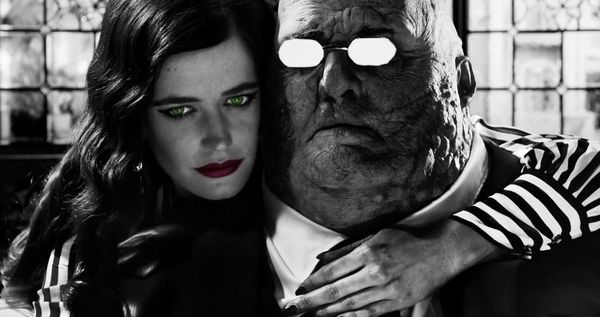Eye For Film >> Movies >> Sin City: A Dame To Kill For (2014) Film Review
Sin City: A Dame To Kill For
Reviewed by: Owen Van Spall

“Walk down the right alley in Sin City, and you can find anything” is an oft-repeated line heard across both of the Sin City films, which are the product of the collaboration between director Robert Rodriguez and the source comics creator (and the film's co-director) Frank Miller. Sadly, what this pair haven’t found in their travels in Sin City is a convincing reason as to why audiences should go back to this material ten years after the first film. With its hardboiled dialogue and super-masculine tone, all set against a monochrome, noir-inflected CGI film world that apes (to a degree) Miller’s bold chiaroscuro artwork, Sin City felt like a clumsy testosterone-fuelled beast even back in 2005. Ten years later, we get pretty much the same thing again. Except in 3D.
The film's plot features three interconnected tales drawn from the original graphic novels and some new material written by Miller especially for the film. Some characters from the initial Sin City film who died are on screen once again, as the time line of these new stories both precedes and overlaps with the events of the first film. All the three stories pivot around the downtown dive bar where dancer Nancy (Jessica Alba, returning from the first film) entertains the whiskey-soaked patrons via her erotic dancing, all the while dreaming of revenge against the city’s bear-like paragon of corruption Senator Rourke (a scenery chewing role par excellence from the go-to guy for these kind of roles: Powers Boothe). If you remember the first Sin City film you’ll know that virginal, innocent Nancy was under the protection of detective John Hartigan (Bruce Willis), who was forced to kill himself by the vengeful Senator after he crippled the elder Rourke’s rapist son. Nancy was left alive, but the struggle within her to avenge Hartigan’s death has reached the point where it has manifested itself in ghostly visions of the old veteran cop which interact with her - which handily allows a cameo from Willis to be squeezed into the proceedings. Nancy’s story doesn’t really develop until the final third of the film, though before this there are plenty of dance sequences of Alba intercut with the other stories, presumably for the delectation of the 17-year old boys in the audience.

Also connecting all these stories is the character of Marv, again played by Mickey Rourke, who is easily the most enjoyable thing about both the Sin City movies. Marv is a strangely childlike bruiser with an exaggerated latex face that suggests a lifetime of facial rearrangement via beatings (it also acts as a meta reference to Rourke’s lifestyle). Aside from watching over Nancy, Marv gets caught up in the plight of one Dwight McCarthy (Josh Brolin, taking over the role from Clive Owen) who is struggling to resist the pull of his siren-like ex-lover Ava Lord (Eva Green, chewing the scenery even more than Boothe), who begs Dwight to help to escape her rich abusive husband and his hulking bodyguard, Manute (Dennis Haysbert). In keeping with the super-noir melting pot that is Sin City, Green is portrayed as the femme fatale of the most extreme kind, Phyllis Dietrichson from Double Indemnity on crack. She is the ultimate siren, a ‘goddess’ as Manute calls her. Women in Sin City tend to be either whores or venus fly traps, and throughout this film a significant amount of violence is meted out to men, in an almost religious fashion, who are either trying to kill or save them. The city itself is likened to a woman explicitly by the main character’s voiceover at one point. In fact, voiceovers tend to be near-constant in this film, with characters' thoughts running along such tracks as: “You go into Sin City with your eyes open, or you don't come out at all.” Deep.
Threading in and out of the above stories is the leaner and more emotionally resonant tale of cocky gambler Johnny (Joseph Gordon-Levitt), who engages in a suicidal mission to beat Senator Rourke at cards. With his natural charisma, an unclear motive for taking on such a powerful figure, and with a stack of odds piled against him, Gordon-Levitt as Johnny is the most sympathetic and interesting figure of the bunch of reprobates here in Sin City, even more than Nancy.
There is some amusement to be had in exploring the streets of Sin City: a place where you could play spot-the-homage in for hours, should you be so inclined. Be it The Big Sleep, Chinatown, Blade Runner, Dark City or Double Indemnity, Sin City steals from them all. Visually the film’s monochrome, luminous (there seems to be a silver sheen over everything) colour palette and the timeless aesthetic where 1950s chrome-heavy cars mix with SWAT helicopters, does offer some appeal at first. The exaggerated effect of it all is intensified in 3D. There are some visual flourishes that please the eye, be it Nancy whiting out the screen as she spits whiskey into the camera, or a lit cigarette tumbling through CGI space. But by the time we get to Nancy’s story, with yet another set of shootings, stabbings and screams to sit through, the entire film has run out of bullets even if the on-screen characters haven’t.
Reviewed on: 25 Aug 2014



















